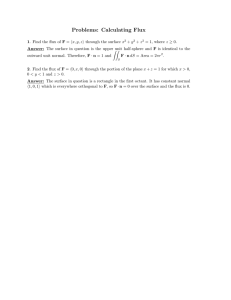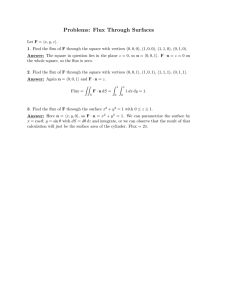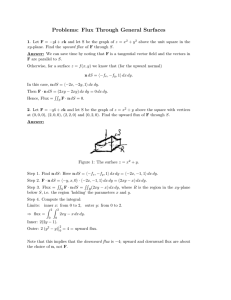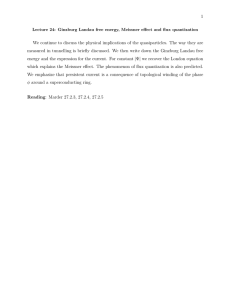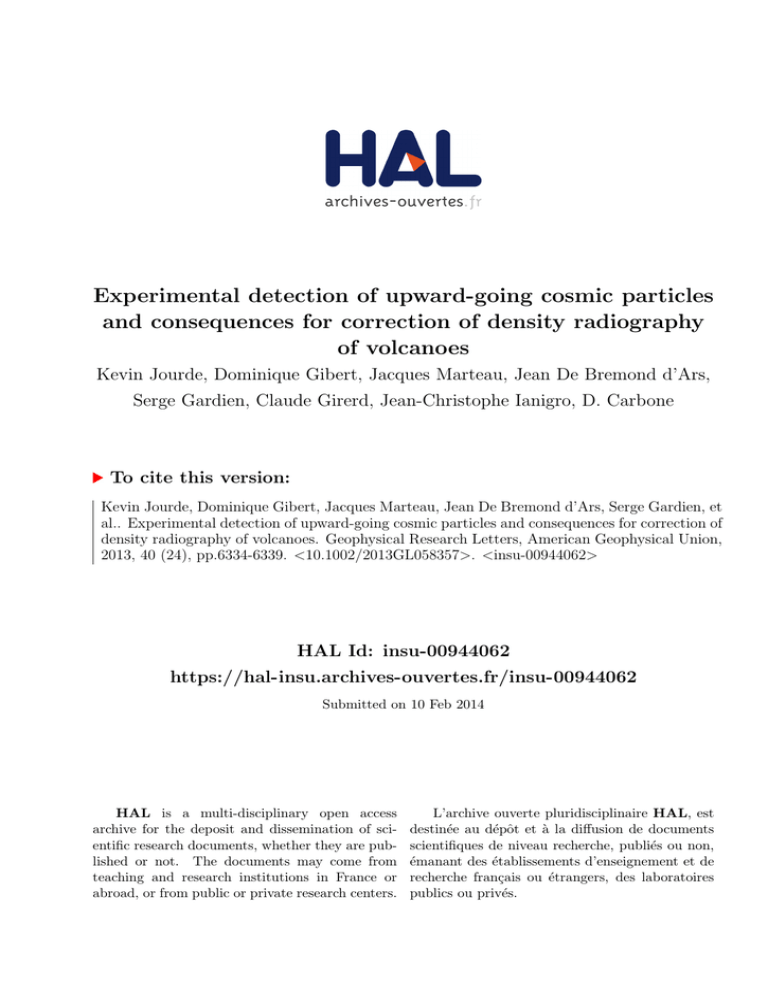
Experimental detection of upward-going cosmic particles
and consequences for correction of density radiography
of volcanoes
Kevin Jourde, Dominique Gibert, Jacques Marteau, Jean De Bremond d’Ars,
Serge Gardien, Claude Girerd, Jean-Christophe Ianigro, D. Carbone
To cite this version:
Kevin Jourde, Dominique Gibert, Jacques Marteau, Jean De Bremond d’Ars, Serge Gardien, et
al.. Experimental detection of upward-going cosmic particles and consequences for correction of
density radiography of volcanoes. Geophysical Research Letters, American Geophysical Union,
2013, 40 (24), pp.6334-6339. <10.1002/2013GL058357>. <insu-00944062>
HAL Id: insu-00944062
https://hal-insu.archives-ouvertes.fr/insu-00944062
Submitted on 10 Feb 2014
HAL is a multi-disciplinary open access
archive for the deposit and dissemination of scientific research documents, whether they are published or not. The documents may come from
teaching and research institutions in France or
abroad, or from public or private research centers.
L’archive ouverte pluridisciplinaire HAL, est
destinée au dépôt et à la diffusion de documents
scientifiques de niveau recherche, publiés ou non,
émanant des établissements d’enseignement et de
recherche français ou étrangers, des laboratoires
publics ou privés.
GEOPHYSICAL RESEARCH LETTERS, VOL. 40, 6334–6339, doi:10.1002/2013GL058357, 2013
Experimental detection of upward going cosmic particles
and consequences for correction of density
radiography of volcanoes
K. Jourde,1 D. Gibert,1,2 J. Marteau,3 J. de Bremond d’Ars,2 S. Gardien,3 C. Girerd,3
J.-C. Ianigro,3 and D. Carbone4
Received 16 October 2013; revised 3 December 2013; accepted 3 December 2013; published 19 December 2013.
[1] Muon tomography measures the flux of cosmic muons
crossing geological bodies to determine their density. The
telescopes used to perform measurements are exposed to
noise fluxes with high intensities relative to the tiny flux of
interest. We give experimental evidences of a so far never
described source of noise caused by a flux of upward going
particles. Data acquired on La Soufrière of Guadeloupe and
Mount Etna reveal that upward going particles are detected
only when the rear side of the telescope is exposed to a
wide volume of atmosphere located below the altitude of
the telescope and with a rock obstruction less than several
tens of meters. Biases produced on density muon radiographies by upward going fluxes are quantified, and correction
procedures are applied to radiographies of La Soufrière.
Citation: Jourde, K., D. Gibert, J. Marteau, J. de Bremond d’Ars,
S. Gardien, C. Girerd, J.-C. Ianigro, and D. Carbone (2013),
Experimental detection of upward going cosmic particles and consequences for correction of density radiography of volcanoes,
Geophys. Res. Lett., 40, 6334–6339, doi:10.1002/2013GL058357.
1. Introduction
[2] Density radiography with cosmic muons aims to
determine the density of geological bodies by measuring
the attenuation of the flux of cosmic muons caused by the
screening effect of a known thickness of rock [Nagamine,
1995; Nagamine et al., 1995; Tanaka et al., 2001, 2005;
Gibert et al., 2010; Lesparre et al., 2012c; Carloganu et
al., 2013]. The most recent applications of muon density
radiography of volcanoes concern monitoring of density
variations [e.g., Tanaka et al., 2009; Shinohara and Tanaka,
2012], and high signal-to-noise ratio is required to measure tiny variations of the muon flux crossing the object of
interest [Nagamine, 2003; Lesparre et al., 2010].
[3] Muon radiography uses telescopes counting and tracking particles coming from given directions [Lesparre et al.,
1
Institut de Physique du Globe de Paris (CNRS UMR 7154), Université
Sorbonne Paris Cité, Paris, France.
2
Géosciences Rennes (CNRS UMR 6118), Université de Rennes 1,
Rennes, France.
3
Institut de Physique Nucléaire de Lyon, Université Claude Bernard,
UMR 5822 CNRS, Lyon, France.
4
Istituto Nazionale di Geofisica e Vulcanologia Sezione di Catania,
Catania, Italy.
Corresponding author: D. Gibert, Institut de Physique du Globe de
Paris (CNRS UMR 7154), Université Sorbonne Paris Cité, Paris, France.
(gibert@univ-rennes1.fr)
©2013. American Geophysical Union. All Rights Reserved.
0094-8276/13/10.1002/2013GL058357
2010], and a main source of noise is due to fake tracks
caused by independent particles that simultaneously hit the
telescope detectors such that their impacts could falsely be
interpreted as produced by a single particle crossing the
detectors. In the present study, we give evidence of a new
type of noise composed of upward going cosmic particles
that may enter the back side of the telescope with trajectories
identical to those of muons emerging from the volcano. Data
acquired on Mount Etna and on La Soufrière of Guadeloupe
[Lesparre et al., 2012c] reveal that upward going noise flux
is present when the rear side of the telescopes is exposed
to large and deep valleys. We discuss the impact of the
measured upward noise on the quality of the density radiographies. Upward going particles are likely to be muons and
high-energy electrons produced in the atmosphere volume
located below the telescope level.
2. The Telescopes
[4] The telescopes are equipped with three detection
matrices of 1616 = 256 (55 cm2 ) pixels formed by intersecting scintillator strips [Lesparre et al., 2012a; Marteau et
al., 2012]. The matrices are synchronized on the same master clock signal with a recently improved timing resolution
of 1 ns, and no shielding was used during these experiments.
[5] The orientation of the telescope is given by the
azimuth, ˇ0 , and the zenith angle, 0 , of the telescope axis
perpendicular to the matrices planes and oriented from rear
to front. ˇ0 is measured from North and positive eastward,
and 0 is positive and measured from the upward vertical
axis to the telescope axis, i.e., 0 = 90ı when the telescope axis is horizontal. We also use slopes ˛F in the forward
direction and slopes ˛B in the backward direction, and measured positive upward so that negative slopes are assigned to
telescope lines of sight looking below the horizontal plane.
[6] A trajectory is determined by the pixels crossed by
the particle. Let ai,j be the front matrix pixel and ck,l be the
rear matrix pixel where i, k, j, and l take values between 1
and N = 16. The combination of all possible pairs of pixels
(ai,j , ck,l ) defines a set of (2N–1)2 = 961 discrete directions of
sight rm,n with m = i – k and n = j – l [Lesparre et al., 2012b;
Marteau et al., 2012]. The angular range spanned by these
directions is set by adjusting the distance 2 D between the
front and rear matrices.
[7] One particle is considered detected when 1 pixel is
fired on each matrix in a 20 ns time interval and their combination matches a linear trajectory. The raw data are corrected
from the instrument acceptance and efficiency to obtain the
absolute flux in s–1 .sr–1 .cm–2 [Lesparre et al., 2012b].
6334
JOURDE ET AL.: UPWARD GOING COSMIC PARTICLES
the same causes of uncertainties, but they have different
amplitude and opposite mean. Consequently,
P(t) = rd F (ttheo , ) + (1 – rd ) F (–ttheo , )
(4)
where 0 rd 1 is the downward flux ratio equals to 0 for a
pure upward going flux and to 1 for a pure downward going
flux. The average of the measured TOFs reads as follows:
hti = ttheo (rd – (1 – rd )),
and
rd =
Figure 1. TOF distribution for the SMTOMO data set shown
as normalized histograms as a function of zenith angle. The
horizon is represented by the dashed line. The blue and red
solid ellipses respectively show the backward (˛B < 0 and
t < 0) and forward (˛F < 0 and t > 0) events corresponding to the downward fluxes. The dashed ellipses show
events corresponding to upward going events from forward
(red ellipse, ˛B < 0 and t > 0) and backward (blue ellipse,
˛F < 0 and t < 0).
[8] Two experiments were performed on La Soufrière of
Guadeloupe volcano [Lesparre et al., 2012a] and a third one
on Mount Etna. Additional calibration data were acquired at
Rennes 1 University (Britanny, France).
3. Analysis Method
[9] We distinguish the forward flux F , whose particles
enter in the telescope through the front matrix and escapes
through the rear matrix, from the backward flux B whose
particles enter through the rear matrix. These fluxes are
separated into their upward going and downward going
components respectively represented by Fu,B and Fd,B :
Fu = F (˛F > 0)
Fd = F (˛F < 0),
(1a)
Bu = B (˛B > 0)
Bd = B (˛B < 0).
(1b)
[10] A particle has a time-of-flight (TOF) t = tC – tA ,
where tA and tC are the detection dates in the front and rear
matrices, respectively. Particles coming from forward have
t > 0, and backward particles have t < 0 (experimental
TOF can be seen in Figure 1. The theoretical unsigned TOF
is given by
ttheo (m, n) = c–1 p
4 D2 + (m2 + n2 ) ı 2 ,
(2)
where ı = 5 cm (pixel size) and c is the light speed.
[11] The TOF probability density distribution, P(t),
may be written as
P(t) = P d (t) + P u (t),
(3)
where P d and P u respectively represent the distributions
of the downward and upward TOFs. These distributions
have the same normalized shape F(mean, std), as they share
hti + ttheo
.
2 ttheo
(5)
(6)
[12] In the remaining we shall distinguish between the
forward ratio, rdF = Fd /(Fd + Bu ) and the backward ratio,
rdB = Bd /(Bd + Fu ).
[13] The processing sequence to obtain the upward flux is
as follows:
[14] 1. For each direction rm,n , the measured TOFs t
are bootstrapped to get hti (equation (5)) and its uncertainty;
[15] 2. The theoretical TOF is computed with
equation (2);
[16] 3. The downward flux ratio rd is derived with
equation (6) and, to further reduce the statistical uncertainty,
rd is averaged over azimuths to be written as a function of
zenith angle only. This simplification is an approximation
when obstruction depends on the azimuth angle;
[17] 4. Finally, we recover
d = rd ,
(7a)
u = (1 – rd ) .
(7b)
[18] We emphasize that d and u cumulate uncertainties
of both rd and , while rd is a more accurate quantity to
prove the existence of an upward going flux.
4. Data Analysis
4.1. Field Measurement Sites
[19] The Roche Fendue site is on the eastern side of La
Soufrière lava dome at an altitude of 1268 m (Table 1,
Figure 2a). The telescope was oriented horizontally to
acquire the data set (RFCALIB) dedicated to upward going
flux study. The front side of the telescope sees an open
space free of rock obstruction down to 6ı below the horizon (Figure 2d). The backward landscape begins with a
small horizontal plateau producing a rock obstruction of
about 0.13 km that remains constant in [0ı ; 6.8ı ] and progressively decreases to zero at 5ı above the horizontal (Figure 2g).
[20] The Savane à Mulets site is located at the edge of
a narrow plateau nearby the western side of La Soufrière
lava dome at an altitude of 1189 m (Table 1, Figure 2b).
The data set (SMTOMO), acquired during a high-resolution
tomography experiment, merges three runs performed at the
same location with different azimuth and zenith angles.
The front side of the telescope sees a landscape occupied by
the dome with an obstruction that varies from about 1 km at
0ı to more than 3 km at 4ı below the horizontal (Figure 2e).
The backward side of the telescope sees a wide open space
6335
JOURDE ET AL.: UPWARD GOING COSMIC PARTICLES
Table 1. Site Characteristics and Main Acquisition Parametersa
Data Set
Altitude a.s.l.
XUTM /YUTM (m) WGS84
Zenith angle 0
Forward azimuth ˇ0
Open space aperture
below horizontal
Matrix distance D
Axial acceptance/Resolution
Acquisition time
Rennes Lab
Roche Fendue
Savane à Mulets
Etna
LBCALIB
RFCALIB
SMTOMO
ETOMO
56 m
(30)601,373/5,330,300
90ı
68.6ı
0ı
1,268 m
(20)643,347 / 1,774,036
90ı
215.5ı
–7.4ı
1,189 m
(20)642,599/1,773,852
80ı –85ı –85ı
32ı –44ı –56ı
–7.4ı
85 cm
5.8 cm2 sr/1.6ı
7 days
85 cm
5.8 cm2 sr/1.6ı
4 days
60 cm
11.5 cm2 sr/2.5ı
22–27–17 days
3,095 m
(33)499,007/4,178,852
85ı –80ı
110ı
–8.0ı –3.9ı 85 cm
5.8 cm2 sr/1.6ı
7–4 days
a
Note that for Etna site, apertures are for ranges of 15 km () and 30 km (). Also for the high definition data sets SMTOMO and ETOMO,
we specify the characteristics of each subdata set when different.
with an obstruction varying from 0.1 km at 0ı to 0.3 km at
10ı (Figure 2h).
[21] The Etna site is located at an altitude of 3095 m,
about three times higher than La Soufrière sites (Table 1,
Figure 2c). The back side of the telescope is directed toward
a deep open space up to 8.0ı below the horizontal for distance up to 15 km (Figure 2i). For a range of 30 km, the
slope of the open space is reduced to 3.9ı . The data set,
called ETOMO, merges the data for two acquisitions per-
formed with a constant azimuth angle and slightly different
zenith angles.
4.2. Results for the Calibration Data Sets
[22] The calibration data set LBCALIB acquired at the
Rennes 1 University site is located on the third floor of building 15 of the Beaulieu campus, at an altitude of 56 m
and 12 m above the ground. The topography is flat in a
wide area of tens of kilometers around the telescope with
Figure 2. (top row) View of the unobstructed landscapes visible from the different measurement sites: (a) forward landscape at the Roche Fendue site; (b) backward landscape at the Savane à Mulets site (telescope circled in red); (c) backward
landscape at the Etna North-East crater site. (middle and bottom rows) Rock obstruction (m) facing the telescope in the
different acquisition configurations: (d,g) RFCALIB; (e,h) SMTOMO; (f,i) ETOMO. Rock obstruction is defined as the total
rock thickness encountered along a given line of sight before it definitely enters into Earth. The telescope acquisition zone
is delimited by a dotted black line.
6336
JOURDE ET AL.: UPWARD GOING COSMIC PARTICLES
1
1
1
1
0.8
0.8
0.8
0.8
0.6
0.6
0.6
0.6
0.4
0.4
0.4
0.4
0.2
0.2
0.2
0.2
0
0
0
−0.2
−0.2
−0.2
−20
−15
−10
−5
0
−20
−15
−10
−5
0
−40
0
1
1
1
0.5
0.5
0.5
0
0
0
−0.5
−0.5
−30
−20
−10
−0.2
0
−25
−20
−15
−10
−5
0
5
4
3
2
1
0
−0.5
−1
−1
0
5
10
15
−1
0
5
10
15
−1
0
5
10
15
20
25
−2
0
5
10
15
20
Figure 3. (top row, from left to right) Downward ratio rdF = Fd /(Bu + Fd ) (red) and rdB = Bd /(Fu + Bd ) (blue). (bottom row,
from left to right) Upward fluxes Fu (red) and Bu (blue).
no open space aperture below the horizontal. The telescope
was oriented horizontally to acquire the data set (labelled
LBCALIB ), and the horizontal lines of sight encompass
a small solid angle symmetrically collecting all types of
fluxes (Fu , Bu , Fd , Bd ), and making the distinction between
upward and downward fluxes impossible (backward and
forward fluxes remain distinguishable with the hightresolution clock).
[23] Both the downward ratio rd and the upward going
flux u derived from LBCALIB and RFCALIB are shown in
Figure 3. For LBCALIB, rd 1 for all slopes except in a
narrow range of ˛F,B > –3ı above the horizon where rd / 1
on both sides. This corresponds to a tiny upward flux of
0.3 sr–1 cm–2 day–1 . The rd values obtained for RFCALIB are
significantly less than 1 for ˛F > –5ı for the forward flux
and for ˛B > –8ı for the backward flux. Backward rdB is significantly lower than forward rdF because the forward flux Fd
is stronger than the backward flux Bu . Forward Fu takes values very close to LBCALIB on the first 5ı below the horizon.
It is slowly decreasing down to 8ı below the horizon where
important error bars, encompassing a null upward flux, forbid any reading (lack of statistics on t). Backward Bu goes
from 0.2 sr–1 cm–2 day–1 to 0 on the first 4ı below the horizon. The difference between forward and backward u may
be explained by the different obstruction patterns.
4.3. Results for the Tomography Data Sets
[24] For tomography measurements, the telescope has its
main axis inclined toward the part of the volcano to be
imaged with the largest acceptance, and the range of slopes
spanned for the forward and the backward direction are
different. The forward flux Fd is strongly attenuated by
the volcano, leading to a lowering of the downward ratio.
Tomography data sets have a good signal-to-noise ratio due
to their long acquisition time. [Lesparre et al., 2010].
[25] Figure 1 presents the azimuthally averaged TOF t
of SMTOMO data subset (i.e., 0 = 85ı and ˇ0 = 44ı ).
The resulting ratio is shown in Figure 3. The forward
obstruction for this data subset goes from a few tens of
meters at the upper edge of the volcano to 1 km for horizontal lines of sight (Figure 2e). Below the horizontal plane,
obstruction quickly reaches 10 km. The backward obstruction is null above the horizon and gradually increases up to
a few hundred meters at ˛B = 10ı (Figure 2h). The discrepancy between the forward and backward obstructions
observed for the SMTOMO data is reflected in the corresponding rd curves (Figure 3, top row, third from left). The
forward ratio rdF = Fd /(Fd + Bu ) (red curve) takes low values 0.2 < rdF < 0.4 for 0 > ˛F > –5ı and linearly grows
to 0.9 at ˛F –15ı . The low rdF values indicate that the
flux is mainly composed of upward going particles coming from backward directions. Conversely, the backward
ratio rdB = Bd /(Bd + Fu ) (blue curve) does not significantly
depart from 1 except at slopes just above the horizon where
rdB = 0.9.
[26] The rd curves obtained for the ETOMO data set
(Figure 3, top row, rightmost) look very similar to the
SMTOMO curves and reflect the obstruction asymmetry
observed for this location (Figures 2f and 2i). However,
rd values significantly lower than 1 are obtained in the
backward direction for ˛B > –5ı , in agreement with the
moderate forward obstruction for the corresponding range
of slopes.
[27] The rd curves obtained from SMTOMO and ETOMO
indicate the presence of an upward going flux u in both
the forward and the backward directions. However, this flux
is always smaller in the forward direction because of the
attenuation produced by the volcano obstruction. The backward upward flux Bu strongly decreases in the first degrees
(about 3ı for both SMTOMO and ETOMO) above the horizon
and reaches zero at 20ı for SMTOMO and 15ı for ETOMO.
Also, the flux (both upward and downward) on ETOMO is
stronger than those on the other acquisition sites. The higher
altitude of this site may be the reason for this difference, but
detailed modelings of low-altitude atmospheric showers are
necessary to document this issue.
6337
JOURDE ET AL.: UPWARD GOING COSMIC PARTICLES
Figure 4. Tomography result of SMTOMO high-definition acquisition (top) without upward flux correction and (bottom)
with upward flux correction. Rock density in g cm–3 .
5. Influence of Upward Noise on
Density Radiographies
[28] The rd curves shown in Figure 3 clearly establish the
existence of an upward going flux of particles whose relative intensity may be larger than the downward going flux
of muons used to compute density radiographies. This produces a dramatic alteration of the density images for slopes
just above the horizontal, and this is particularly regrettable
since this concerns the deepest and generally most interesting parts of the studied volcano. A density radiography is
obtained by computing the opacity, %m,n [g.cm–2 ], for each
line of sight, rm,n , spanned by the telescope:
Z
%m,n =
()d = Lm,n ,
(8)
Lm,n
where is the position along rm,n of length Lm,n across the
volcano of density . The opacity is converted into average
density m,n = %m,n /Lm,n to construct the radiography image.
[29] The opacity in equation (8) is determined by searching the cutoff energy Emin (%) that reproduces the measured
flux of muons,
m,n , by integrating
the incident differential
flux ˆ0 cm–2 sr–1 s–1 GeV–1 ,
Z
1
m,n =
ˆ0 (E, )dE
–2 –1 –1 cm sr s .
[2006]. Equation (9) shows that a positive bias in m,n
inducts an underestimate of Emin , hence of opacity %m,n .
[30] To illustrate the importance of the bias produced by
an upward going flux on reconstructed opacity images, we
apply an upward flux correction to the SMTOMO data set.
Computing rd for each rm,n , we use equation (7a) to obtain
d
m,n
to be used in equation (9) instead of the total flux m,n .
[31] The upper part of Figure 4 shows the radiography
obtained by using m,n in equation (9), and the bottom part of
the figure shows the corrected radiography obtained by using
d
m,n
. The low density region observed for –10ı < ˛F < 0ı
in the biased radiography is strongly reduced both in intensity and extent in the corrected radiography. In particular,
higher densities are obtained in the right-lower part (i.e.,
South region of the lava dome) of the corrected radiography
in full agreement with other available data. The low density
region that persists in the left-lower region of the corrected
radiography agrees with electrical impedance tomography
[Nicollin et al., 2006] that indicates the presence of cavities
and hydrothermal reservoir in this part of the lava dome. The
densities obtained after upward going flux correction remain
low in absolute value, and this may indicate that further
improvements of open sky flux models are necessary
(9)
6. Conclusion
Emin (%m,n )
Models for ˆ0 are discussed by Lesparre et al. [2010] and,
in the present study, we use the model given by Tang et al.
[32] The data analyzed in the present study demonstrate
the existence of a flux of upward going particles whose
6338
JOURDE ET AL.: UPWARD GOING COSMIC PARTICLES
trajectories might be confounded with those of downward
going muons crossing the volcano to radiography. The intensity of the upward going flux relative to the downward going
flux may exceed 50% (Figure 3) and, if no distinction is
made between these two types of fluxes, the resulting radiographies display underestimated densities in their bottom
part for slopes ˛ < 15ı (Figure 4). High-resolution clocking
systems are mandatory to acquire particle direction information allowing one to separate upward going and downward
going fluxes in order to obtain reliable radiographies before
performing a fine geophysical interpretation, at least in the
first few degrees above the horizon. Upward going particles
are likely to be created near the ground in the volume of
atmosphere located below the altitude of the telescope. More
dedicated field studies and atmospheric shower modelings
are necessary to further document their origin.
[33] Acknowledgments. Guadeloupe experiments received the help
from colleagues of the Volcano Observatory, the crews of the French
Civil Security helicopter basis (http://www.helicodragon.com), and members of the National Natural Park of Guadeloupe (http://www.guadeloupeparcnational.fr). On-field maintenance of the telescope is ensured by
Fabrice Dufour. Mount Etna experiments received the help of colleagues of
the Volcano Observatory at Catania. We acknowledge the financial support
from the UnivEarthS Labex program of Sorbonne Paris Cité ( ANR-10LABX -0023 and ANR -11- IDEX -0005-02). This is IPGP contribution 3464.
We are grateful to Tony Hurst and an anonymous reviewer who helped to
improve the manuscript.
[34] The Editor thanks Tony Hurst and an anonymous reviewer for their
assistance in evaluating this paper.
References
Carloganu, C., et al. (2013), Towards a muon radiography of the Puy de
Dôme, Geosci. Instrum. Method. Data Syst., 2, 55–60.
Gibert, D., F. Beauducel, Y. Déclais, N. Lesparre, J. Marteau, F. Nicollin,
and A. Tarantola (2010), Muon tomography: Plans for observations in
the Lesser Antilles, Earth Planets Space, 62, 153–165.
Lesparre, N., D. Gibert, J. Marteau, Y. Déclais, D. Carbone, and E. Galichet
(2010), Geophysical muon imaging: Feasibility and limits, Geophys. J.
Int., 183, 1348–1361.
Lesparre, N., J. Marteau, Y. Déclais, D. Gibert, B. Carlus, F. Nicollin, and
B. Kergosien (2012a), Design and operation of a field telescope for cosmic ray geophysical tomography, Geosci. Instrum. Method. Data Syst., 1,
33–42.
Lesparre, N., D. Gibert, and J. Marteau (2012b), Bayesian dual inversion
of experimental telescope acceptance and integrated flux for geophysical
muon tomography, Geophys. J. Int., 188, 490–497.
Lesparre, N., D. Gibert, J. Marteau, J.-C. Komorowski, F. Nicollin, and O.
Coutant (2012c), Density muon radiography of La Soufrière of Guadeloupe Volcano: Comparison with geological, electrical resistivity and
gravity data, Geophys. J. Int., 190, 1008–1019.
Marteau, J., D. Gibert, N. Lesparre, F. Nicollin, P. Noli, and F. Giacoppo
(2012), Muons tomography applied to geosciences and volcanology,
Nucl. Instrum. Methods Phys. Res., Sect. A, 695, 23–28.
Nagamine, K. (1995), Geo-tomographic observation of inner-structure of
volcano with cosmic-ray muons, J. Geogr., 104, 998–1007.
Nagamine, K. (2003), Introductory Muon Science, pp. 208, Cambridge
Univ. Press, Cambridge, U. K.
Nagamine, K., M. Iwasaki, K. Shimomura, and K. Ishida (1995), Method
of probing inner-structure of geophysical substance with the horizontal cosmic-ray muons and possible application to volcanic eruption
prediction, Nucl. Instrum. Methods Phys. Res., Sect. A, 356, 585–595.
Nicollin, F., D. Gibert, F. Beauducel, G. Boudon, and J.-C. Komorowski
(2006), Electrical tomography of La Soufrière of Guadeloupe Volcano:
Field experiments, 1D inversion and qualitative interpretation, Earth
Planet. Sci. Lett., 244, 709–724.
Shinohara, H., and H. Tanaka (2012), Conduit magma convection of a
rhyolitic magma: Constraints from cosmic-ray muon radiography of
Iwodake, Satsuma-Iwojima volcano, Japan, Earth Planet. Sci. Lett., 349,
87–97.
Tanaka, H., K. Nagamine, N. Kawamura, S. N. Nakamura, K. Ishida, and
K. Shimomura (2001), Development of the cosmic-ray muon detection
system for probing internal-structure of a volcano, Hyperfine Interact.,
138, 521–526.
Tanaka, H., K. Nagamine, S. N. Nakamura, and K. Ishida (2005), Radiographic measurements of the internal structure of Mt. West Iwate
with near horizontal cosmic ray muons and future developments, Nucl.
Instrum. Methods Phys. Res., Sect. A, 555, 164–172.
Tanaka, H., T. Uchida, M. Tanaka, H. Shinohara, and H. Taira (2009),
Cosmic-ray muon imaging of magma in a conduit: Degassing process
of Satsuma-Iwojima Volcano, Japan, Geophys. Res. Lett., 36, L01304,
doi:10.1029/2008GL036451.
Tang, A., G. Horton-Smith, V. A. Kudryavtsev, and A. Tonazzo (2006),
Muon simulations for Super-Kamiokande, KamLAND, and CHOOZ,
Phys. Rev. D, 74, 053007.
6339

